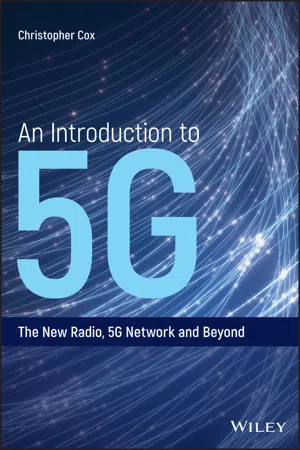
- English
- ePUB (mobile friendly)
- Available on iOS & Android
About this book
A comprehensive and approachable introduction to 5G
Written by a noted expert on the subject, An Introduction to 5G: The New Radio, 5G Network and Beyond offers an introductory system-level guide to 5G. The material covered includes:
- The use cases and requirements of the 5G system
- The architecture of the next generation radio access network and the 5G core
- The principles of radio transmission, millimetre waves and MIMO antennas
- The architecture and detailed design of the 5G new radio
- The implementation of HTTP/2 on the service-based interfaces of the 5G core
- The signalling procedures that govern the end-to-end-operation of the system
- The new features that are introduced in Releases 16 and 17
An Introduction to 5G is written for engineering professionals in mobile telecommunications, for those in non-technical roles such as management, marketing and intellectual property, and for students. It requires no more than a basic understanding of mobile communications, and includes detailed references to the underlying 3GPP specifications for 5G. The book's approach provides a comprehensive, end-to-end overview of the 5G standard, which enables readers to move on with confidence to the more specialized texts and to the specifications themselves.
Frequently asked questions
- Essential is ideal for learners and professionals who enjoy exploring a wide range of subjects. Access the Essential Library with 800,000+ trusted titles and best-sellers across business, personal growth, and the humanities. Includes unlimited reading time and Standard Read Aloud voice.
- Complete: Perfect for advanced learners and researchers needing full, unrestricted access. Unlock 1.4M+ books across hundreds of subjects, including academic and specialized titles. The Complete Plan also includes advanced features like Premium Read Aloud and Research Assistant.
Please note we cannot support devices running on iOS 13 and Android 7 or earlier. Learn more about using the app.
Information
1
Introduction
1.1 Architecture of a Mobile Telecommunication System
1.1.1 High‐level Architecture

1.1.2 Internal Architecture of the Mobile
1.1.3 Architecture of the Radio Access Network

Table of contents
- Cover
- Table of Contents
- An Introduction to 5G
- Copyright
- Dedication
- Preface
- Acknowledgements
- 1 Introduction
- 2 Architecture of the Core Network
- 3 Architecture of the Radio Access Network
- 4 Spectrum, Antennas and Propagation
- 5 Digital Signal Processing
- 6 Multiple‐antenna Techniques
- 7 Architecture of the 5G New Radio
- 8 Cell Acquisition
- 9 Random Access
- 10 Link Adaptation
- 11 Data Transmission and Reception
- 12 Air Interface Layer 2
- 13 Registration Procedures
- 14 Security
- 15 Session Management, Policy and Charging
- 16 Mobility Management in RRC_CONNECTED
- 17 Mobility Management in RRC_IDLE
- 18 Mobility Management in RRC_INACTIVE
- 19 Inter‐operation with the Evolved Packet Core
- 20 Release 16 and Beyond
- Further Reading
- Index
- End User License Agreement